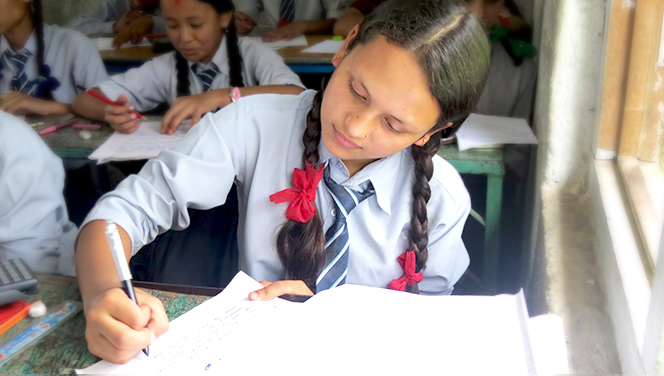Field Report by: Amit Lama
Post by: Sangya Gyawali
In a world that’s constantly trying to achieve more and fight against social inequality, it’s crucial to stop and recognize past achievements and success. Otherwise, it’s easy to lose momentum in this race towards social justice. Every year, International women’s day, celebrated on March 8th, acknowledges the need for this recognition. Rukmini Foundation and Shikharapur Community School collaborated with various local programs this past week to celebrate the social, economic, political, and cultural achievements and continual struggles of women in Nepal.

Attendants of the program holding up signs of empowerment in Nepali. The first sign translates to ” Lets protect women’s glory and dignity”
Rukmini and Shikharapur Community School put together various programs which brought together women, parents, teachers, and students with love and respect for women. The program was designed by Amit Lama (PBL instructor) in coordination with Rubi Balami (Class 9), Anjana Tamang (Class 9), Dipen Acharya (Class 8). The program was divided into four parts, speeches, musical play, poem recitation, and morality play.
Often, what we need the most is to share stories, of personal battles and encouragement in an attempt to create hope. The program began with women giving speeches as a form of empowerment. They all covered individual stories of local women, concluding with the same message of promoting equal rights and possibilities and potential towards a better future. Each story addressed ways to claim equality and accounts of concerns and resistance in the community or at home. At the end, the common theme was that of ‘self claimed rights and equalities’ for women.
Afterwards, there were two plays presented to showcase the daily struggles of Nepali women and the changes that are taking place to overcome such situations. A Day of Woman in Nepal, was a musical depicting a “day in a life” story of a woman in Nepal. One particular song, “Our Life”, was very heavy in symbolism and showed students playing the role of a women who, for example, had their mouths covered with scarf and bodies tightened with rope. The scarf symbolized the suppression of voice rendering women unable to express their thoughts and speak their minds. The body tightened with rope signified the societal norms that keep women stagnated, unable to pursue a life of purpose and ambitions.

Students perform speeches and share stories about women’s right and empowerment with the audience
The morality play called, “The Voice echoes in the Women’s Heart, A Wish to Fly,” echoed the voices of radical feminist thought. The play centered around the story of Sima Khatri, a married woman, who suffers through pain and sacrifices brought about by her husband and mother in law. Sima, 22 years old, is forced to marry a man in his mid-fifties, at the age of 17. She gives birth to two girls, and no sons. This gives all the reason for her husband and mother in law to torture her everyday. Fed up with her situation, Sima becomes more cognizant to her inner voice demanding her to question her own existence. When the voice gets louder and unbearable, she gains confidence, and is left with no choice but to follow her heart. Wanting to live the life of her dreams, she resists and fights with her husband’s family and one day, leaves to establish an identity of her own. Although other sub stories of issues of women are integrated within the play, Sima remains the central character. At the end Sima throws away the chains that bind her, symbolically representing her denial of patriarchal obligations cast over female self-claimed freedom. The stage performance of the song “Ma Ko Hu? (Who am I?)” attempts to empower women who have been silenced and have lost their voice.

Participants of the play use bandanas to cover their mouth to symbolize the suppression of women’s voice in Nepali society
The Poem recited were those of world renowned female poets. These included, A Woman’s Worth by Ashanty Holiday, Woman Work by Maya Angelou, Any Woman by Kathrin Tynan, and many other English and Nepali compositions. The purpose of this feature was to bring together various perspectives on women, by women, to represent their importance in society.

Program participant passionatley recites a poem on stage
In addition to the speeches, musical play, morality play, and poem recitation, there was a banner exhibition and social media campaign ran throughout the program. The banner displayed posters, cards, various slogans, and promises as a message towards promoting equality, respect and fair opportunity for women. The program also reached people through social media (ie. Facebook), with the tag #shikhrapurspeaksforwomen, #pledgeforparity, and #IWD2016. The posts created much engagement with participants over social media sharing and posting their concerns for women.
Overall, March 8th was a day of encouragement, awareness, and celebration. Rukmini, along with billions of people all around the world offered a much needed spotlight to issues of women inequality and the persistent opportunity gap that continues to plague the developing world. But, like all plagues this too shall pass in the wake of resilient human spirit.
- Experimenting with Education in Nepal - December 24, 2016
- Sabita Didi Sees Ability Where Others May See Disability - December 22, 2016
- Role of Mindfulness and Focus in Success – a Didi’s Teaching - September 29, 2016
- Tsultrim Sangmo Lama: Going Back to School - August 28, 2016
- Celebration, Awareness, & Empowerment: International Women’s Day 2016 - March 21, 2016

